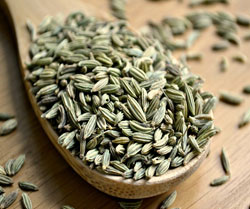Dry GingerGinger produces clusters of white and pink flower buds that bloom into yellow flowers.Because of its aesthetic appeal and the adaption of the plant to warm climates,giner is often used as landscaping around subtropical homes. Botanical Name : Zingibar officinale RFamily : Zingiberaceae Harvesting Season : Dec to Jan |
 |
TurmericIf cardamom is the queen of spices and peppers the black king, then turmeric is definitely the taste of India; because without turmeric every Indian kitchen is bare and incomplete. Indian Turmeric, which is also popularly known as "Indian Saffron”, because of its bright yellow color, is considered the best in the world. Turmeric is mildly aromatic and has scents of orange or ginger. Turmeric has a pungent, bitter flavor. Botanical Name: Curcuma LongaFamily: Zingiberaceae Common Name: Haldi Part Used: Rhizome (Dried Roots) Form Available: Haldi Whole and Powder |
 |
Cumin SeedsCumin is native to Egypt and has been cultivated in the Middle East, India, China and Mediterranean countries for millennia. Throughout history, cumin has played an important role as a food and medicine and has been a cultural symbol with varied attributes. Cumin has been in use since ancient times. Seeds excavated at the Syrian site Tell ed-Der have been dated to the second millennium BC. They have also been reported from several New Kingdom levels of ancient Egyptian archaeological sites. Botanical Name : Cuminum cyminum LFamily : Umbelliferae Harvesting Season : February to March |
 |
ChiliChili peppers have been a part of the human diet in the Americas since at least 7500 BC. There is archaeological evidence at sites located in southwestern Ecuador that chili peppers were domesticated more than 6000 years ago, and is one of the first cultivated crops in the Central and South Americas that is selfpollinating. Botanical Name : Capsicum annuum LFamily : Solanaceae Harvesting Season : January, February, March |
 |
Fennel SeedsFennel is a plant species in the genus foeniculum.It is a member of the family Apiaceae.It is indigenous to the shores of the Mediterranean, but has become widely naturalised in many parts of the world. especially on dry soils near the sea-coast & on riverbanks. Botanical Name : Foeniculum VulgareFamily : Apiaceae(Umbelliferae) Harvesting Season : Jan to Feb |
 |
CorianderIronically, the history of coriander begins with its strong bug-like smell rather than its medicinal or culinary qualities. Coriander is believed to be derived from the Greek word koros which means insect or the Greek word koriannon, meaning bug. The specific name refers to its cultivation in gardens. Taken together, the full scientific name calls coriander ‘the cultivated buggy-smelling plant. Botanical Name : Coriander Sativam LFamily : Umbelliferae Harvesting Season : February to March |
 |
Bay leavesIt is native of Asia Minor and is known by the name of 'Sweet bay', 'bay laurel', 'Noble laurel' and 'True laurel'. Indian bay leaf has similar fragrance and taste to cinnamon bark, but milder. The aroma is more closely related to cassia. The flavor can be improved and bitterness reduced by using appropriate drying procedure, bitterness is significantly reduced. The leaves are immediately dried after plucking without exposing them to sunlight After manual plucking and sorting, the leaves are quickly dried without exposure to sunlight. The bright green color clearly defines the quality of the bay leaves. Botanical Name: Cinnamomum TamalaFamily: Hindi name: Tej Patta, Tej Pat, Tejpat, Tejpata Part Used: Leaf Form Available: Dried Leaves, Powder |
 |
